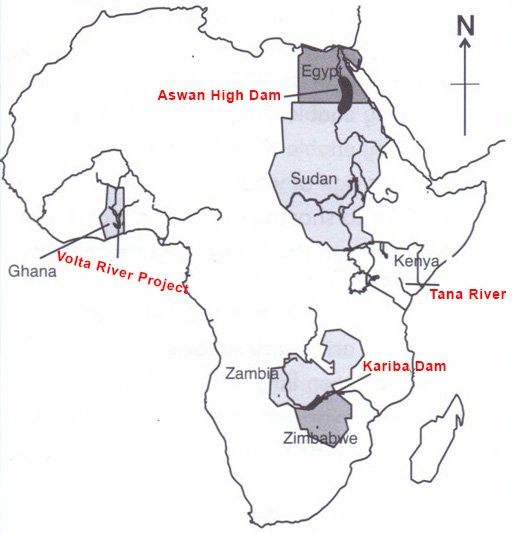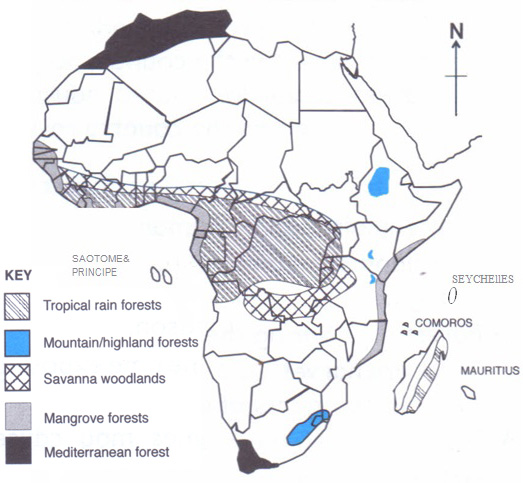Agriculture
Agriculture is the growing of crops and rearing of animalsCrop farming
Cocoa in Ghana
- Cocoa is an equatorial crop. - It is grown in West Africa in countries like Cote d'ivoire, Ghana, Nigeria, Togo and Benin.Conditions favouring the growth of cocoa
- High rainfall of over 1500mm
- High temperature of at least 24°C
- High humidity
- Deep well-drained fertile soils
- Protection from strong winds and sunlight
Uses of cocoa
- Making cosmetics and medicine
- Manufacture of chocolate and sweets
- Making of drinking chocolate
Importance of cocoa to the economy of Ghana
- Earns the country foreign exchange
- It creates jobs
- Leads to the development of infrastructure
- Improves the living standards of people
Cloves in Tanzania
- Cloves are mainly grown in the islands of Zanzibar and Pemba.- They were introduced by the Arabs
Conditions favouring the growth of cloves
- High temperature of more than 24°C throughout the year
- High humidity throughout the year
- Deep fertile soils
- Low altitudes
Uses of cloves
- Making perfumes
- Used to make mouthwash
- Used in making medicine
- Used in making of food spices
- Used in making cigarettes
Importance of cloves to the economy of Tanzania
(i) Earns the country foreign exchange.(ii) It creates jobs.
(iii) Leads to development of infrastructure.
(iv) Improves the living standards of the people.
Pyrethrum in Kenya
- It was introduced in Kenya by the British.- It is a highland crop.
Areas where pyrethrum is grown in Kenya
Pyrethrum in Kenya is grown in the following areas:(i) Kiambu
(ii) Nyandarua
(iii) Kisii
(iv) Bomet
(v) Molo
(vi) Nyamira
Uses of pyrethrum
- It is mainly used in making of insecticides.Conditions favouring the growth of pyrethrum
(i) High rainfall which is well distributed throughout the year.(ii) It requires high altitude.
(iii) Cool temperature below 15°C.
(iv) Deep well drained red volcanic soil.
Importance of pyrethrum to the economy of Kenya
- Earns the country foreign exchange
- Creation of jobs
- Leads to development of infrastructure
- Improves the living standards of the people
Pastoral farming in Africa
- This is the keeping of animals for subsistence purposes on large scale.- Pastoralists keep camels, goats, cattle, sheep and donkeys.
- It is practised in areas that receive little rainfall.
- Pastoral farming is carried out among the Maasai, Fulani and Tswana.
Conditions favouring pastoral farming in Africa
The following are the conditions which favour pastoral farming in Africa.(a) Plenty of pastures.
(b) Low population which creates more grazing land.
(c) Absence of tsetse flies.
(d) Flat land which favours easy movement of people and their animals.
Benefits of pastoral farming in Africa
(a) Provision of food to the pastoral communities. (b) Some animals are used to provide transport. (c) Hides and skins of some animals are a source of raw materials for leather industry.Problems facing pastoral farming in Africa
The following are the problems facing pastoral arming in Africa: (a) Pests and diseases. (b) Prolonged drought. (c) Overstocking. (d) Poor quality of animal breeds. (e) Poor quality pastures for the animals. (f) Frequent attacks by wild animals. (g) Poor means of transport.Measures taken in order to improve pastoralism in Africa
- Encouraging pastoral communities to live a more permanent way of life
- Sinking boreholes to provide water
- Provision of veterinary services to pastoral communities
- Encouraging pastoral communities to reduce the number of animals they keep
Multi-Purpose River Projects
- These are projects established along major rivers for different development purposes mostly hydro-electric power production and irrigation.- The following table shows major multi-purpose river projects in Africa
| River Project | Country where found | River where located | Main purpose |
|---|---|---|---|
| Volta River scheme (Akosombo) |
Ghana | River Volta | Hydro-electric power |
| Aswan High Dam | Egypt | River Nile | - Water for irrigation - Hydro-electric power production |
| The River Tana Project (Seven folks Dam) |
Kenya | River Tana | Hydro-electric power |
| Kariba Dam | Zimbabwe - Zambia border | River Zambezi | Hydro-electric power production |

A map of several African River Projects - image courtesy
Reasons for the establishment of multi-purpose river projects in Africa
(a) Provision of hydro-electric power.(b) Provides water for irrigation.
(c) Controlling floods.
(d) Tourist attraction sites.
(e) Fishing grounds.
(f) Inland water ways.
Benefits of multi-purpose river projects in Africa
- Production of hydro-electric power has led to growth of industries
- Provides water for irrigation
- Provides water for domestic and industrial use
- They are used to control floods in lowlands
- They are important fishing grounds
- The dams and lakes are major tourist attractions
- They are used as major inland water ways
Problems facing multi-purpose river projects in Africa
(a) Siltation of the dams which reduces the water holding capacity.(b) Lack of sufficient funds to manage the projects.
(c) Fluctuating volumes of water especially during the dry season.
(d) Displacement of people when establishing the projects.
(e) Waterborne diseases are experienced in areas where irrigation is carried out.
Forestry
- Forestry is the practice of planting trees and conserving the existing forest for future use.- There are two types of forests. These are:
(a) Natural forests which grow on their own.
(b) Planted forests which are planted by human beings.
Location of major forests in Africa
- The map below shows the location of major forests in Africa.
A the location of forest zones in Africa - image courtesy
Importance of forests to the economy of The Democratic Republic of Congo (DRC)
- Forests in DRC are mainly natural forests.- The types of trees found there are mainly hardwoods.
Importance
(a) Earns the country foreign exchange from export of wood and wood products.(b) Provides homes for wild animals.
(c) Forestry has led to improved living standards of the people who benefit through employment.
(d) Forestry earns the government revenue.
Problems facing forestry in DRC
(a) Overexploitation by human beings.(b) Poor tree harvesting techniques.
(c) Trees do not grow in pure stands.
(d) Presence of dangerous wild animals.
(e) The forests are dense and this hinders transport.
(f) The trees are huge which makes it difficult to harvest using simple tools.
Importance of forestry to the economy of Swaziland
- The forests in Swaziland are mainly planted forests.- They are important for the following reasons:
(i) Forests earn the country foreign exchange.
(ii) They provide raw materials for paper making.
(iii) Forests create jobs for many people.
(iv) Forests have helped to raise the people's living standards.
(v) Forestry has promoted industrial development in the country by providing raw materials for related industries.
(vi) Forestry earns the country revenue. Problems facing forestry in Swaziland
Problems facing forestry in Swaziland
(a) Overexploitation by human beings.(b) Swaziland sometimes experiences severe drought.
(c) Forest fires during the dry season.
(d) Trees are harvested at the same time exposing the soils to agents of erosion.
(e) Harvesting of trees sometimes may cause rivers to dry up.
Mining
Extraction of selected minerals mined in Africa
- Mining is the extraction of minerals from the earth's surface.- These minerals exist in form of solids, gases and liquids.
- The following table shows some minerals in Africa, how they are mined, where they are mined and their uses.
Premium Content
